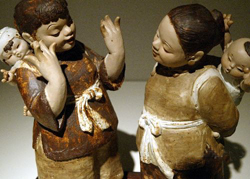
Zhang Shouzhi, 74, was exceedingly excited for a day: "Today is
a historic moment. I'll never forget it."
The senior ceramist made the remark at the opening ceremony for
the Exhibition of Modern Chinese Ceramic and Pottery Art 2006 at
the National Art Museum of China in downtown Beijing on June
30.
For various reasons, Chinese ceramic and pottery art has been
excluded from the categories of "fine arts" and instead labeled as
"arts and crafts" under the category of "light industry products"
over the past few decades, explained Zhang, whose artistic career
started in the early 1950s.
"Finally, our works, churned out with our sweat, passion and
wisdom, have been recognized as part of the country's fine arts,"
Zhang said.
Many of the exhibited works will be included in the permanent
collection of China's top art museum for modern and contemporary
art, he said.
Huge exhibition
Publicized as the largest and most inclusive exhibitions ever
held in China, this one encompasses 230 pieces or sets of ceramic
and pottery art works created by 163 artists.
These were carefully selected from some 1,450 entries that came
from all over the country by a panel of art historians and veteran
ceramists and potters. Since last September, the panel had traveled
nationwide to meet local artists and select exhibits, according to
the museum's Vice-Director Yang Bingyan, who headed the selection
panel for the exhibits.
He said that the judging criteria for the exhibits range from
the materials, techniques, modeling, decorations, cultural
significance, to local cultural flavors, and the creators' personal
styles.
The exhibition also features a special showcase for at least 40
modern ceramic designs from Chaozhou, South China's Guangdong
Province, one of the emerging new forces in ceramic
productions.
The art museum has dedicated eight of its spacious display halls
to these exhibits.
To help visitors better understand the art show, the museum
offers audio and touch-screen guides and videos about the history
of Chinese porcelain and the featured artists.
In the display halls, lecturers will also guide the viewers
through the key exhibits.
"The grand exhibition is a rare feast for the eyes for lovers of
Chinese porcelain ware. And it will certainly change the way local
audiences view the traditional art genre," said Qiu Gengyu, a
ceramist and professor at Tsinghua University's School of Art and
Design.
Among the exhibited works are not only representative works from
major production bases for traditional porcelain ware, but also
works from the younger generations of artisans, including teachers
and students from ceramic art schools, colleges and private
studios, said Qiu, who is a member of the selection panel.
It seems that the old masters are "tiptoeing the borderline
between the traditional and the modern" as is illustrated by their
displayed works.
Older generations of master ceramists such as Gao Zhuang
(1905-86), Shi Yuren (1928-96), Gao Haigeng (1939-85), Xu Xingtai
(1941-2006) and Wang Xiliang have managed to incorporate
traditional Chinese art elements into their creations with a
distinctive Chinese flavor, be it a vat, a vase, tableware, or a
set of teapots.
By contrast, the ceramics and pottery pieces by contemporary
Chinese artists are widely different from those made by their
ancestors and older generations.
Their works are not bowls, plates or vases with elegant patterns
and smooth surfaces people usually find on dinner tables or in
furnishing shops. Compared with works by the old masters, they seem
to be a little Western, a little more modern.
They sport strange shapes, formations, patterns and demand
attention with their striking visual effects. Some works look like
anything but ceramics or pottery works, all reveling in the
artists' angst and desire to break from traditions, critics
say.
However, "they do reflect in one way or another what's happening
in China's ceramics and pottery community nowadays," Lu Pinchang, a
renowned experimental ceramist and professor with the Central
Academy of Fine Arts, told last weekend's seminar on contemporary
ceramics and pottery art held at the National Art Museum of
China.
Ambitious curator
"Porcelain-making enjoys a pretty long history in China. And
pieces made in ancient times have exerted far-reaching influences
on ceramic art in other parts of the world," said museum curator
Fan Di'an.
Over the past century, modern Chinese ceramic and pottery
artisans have made excellent achievements, by inheriting from, and
improving upon, the past to forge their own ceramic and pottery
languages, said Fan, also a veteran art critic.
However, "it was not until the early 1980s, when China started
its reforms and opening up, that ceramic and pottery artists were
fully exposed to the influences of Western art that Chinese ceramic
and pottery art entered a golden era with unprecedented
diversification in styles, sub-genres and hybrids of artistic forms
integrating the traditional elements with contemporary art," he
said.
Since its founding in 1963, the National Art Museum of China has
accumulated about 70,000 artworks in its collection.
However, only a small number of ceramic and pottery works are
included, admitted Fan.
"Fortunately, efforts have been stepped up since early 2004 to
enlarge the museum's collection of ceramic and pottery and to carry
out academic research and public education on this ever green art
genre, with support from the Ministry of Finance," he explained but
declined to reveal how much money will be allocated each year for
future purchases.
Fan is still unsure how many of the exhibited works will be kept
in the museum after the exhibition ends on August 3.
He only predicted that "some day, we can say in confidence, 'If
you want to enjoy ancient Chinese ceramic and pottery, please go to
the Palace Museum where the best of ancient Chinese porcelain
dating back to the Ming (1368-1644) and Qing (1644-1911) dynasties
is kept. And if you want to see modern and contemporary Chinese
ceramic and pottery art, please come to the National Art Museum of
China'."
(China Daily July 10, 2006)
|

